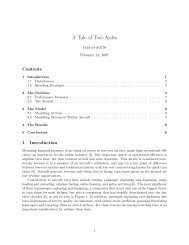Neural Models of Bayesian Belief Propagation Rajesh ... - Washington
Neural Models of Bayesian Belief Propagation Rajesh ... - Washington
Neural Models of Bayesian Belief Propagation Rajesh ... - Washington
Create successful ePaper yourself
Turn your PDF publications into a flip-book with our unique Google optimized e-Paper software.
11.4 Results 249<br />
again leaky-integrator neurons as described by Equation 11.44, with the driving<br />
inputs r(t) being determined by inhibition between the summed inputs<br />
from the two chains in the motion detection network (as in equation (11.42)).<br />
The output <strong>of</strong> the model is “L” if dL(t) > c and “R” if dR(t) > c, where c is<br />
a “confidence threshold” that depends on task constraints (for example, accuracy<br />
vs. speed requirements) [35].<br />
Figure 11.7B and C shows the responses <strong>of</strong> the two decision neurons over<br />
time for two different directions <strong>of</strong> motion and two levels <strong>of</strong> coherence. Besides<br />
correctly computing the direction <strong>of</strong> coherent motion in each case, the<br />
model also responds faster when the stimulus has higher coherence. This phenomenon<br />
can be appreciated more clearly in figure 11.7D, which predicts progressively<br />
shorter reaction times for increasingly coherent stimuli (dotted arrows).<br />
Comparison to Neurophysiological Data<br />
The relationship between faster rates <strong>of</strong> evidence accumulation and shorter reaction<br />
times has received experimental support from a number <strong>of</strong> studies. Figure<br />
11.7E shows the activity <strong>of</strong> a neuron in the frontal eye fields (FEF) for fast,<br />
medium, and slow responses to a visual target [39, 40]. Schall and collaborators<br />
have shown that the distribution <strong>of</strong> monkey response times can be reproduced<br />
using the time taken by neural activity in FEF to reach a fixed threshold<br />
[15]. A similar rise-to-threshold model by Carpenter and colleagues has received<br />
strong support in human psychophysical experiments that manipulate<br />
the prior probabilities <strong>of</strong> targets [3] and the urgency <strong>of</strong> the task [35].<br />
In the case <strong>of</strong> the random-dots task, Shadlen and collaborators have shown<br />
that in primates, one <strong>of</strong> the cortical areas involved in making the decision regarding<br />
coherent motion direction is area LIP. The activities <strong>of</strong> many neurons in<br />
this area progressively increase during the motion-viewing period, with faster<br />
rates <strong>of</strong> rise for more coherent stimuli (see figure 11.7F) [37]. This behavior is<br />
similar to the responses <strong>of</strong> “decision neurons” in the model (figure 11.7B–D),<br />
suggesting that the outputs <strong>of</strong> the recorded LIP neurons could be interpreted<br />
as representing the log-posterior ratio <strong>of</strong> one task alternative over another (see<br />
[3, 12] for related suggestions).<br />
11.4.3 Example 3: Attention in the Visual Cortex<br />
The responses <strong>of</strong> neurons in cortical areas V2 and V4 can be significantly modulated<br />
by attention to particular locations within an input image. McAdams<br />
and Maunsell [23] showed that the tuning curve <strong>of</strong> a neuron in cortical area V4<br />
is multiplied by an approximately constant factor when the monkey focuses<br />
attention on a stimulus within the neuron’s receptive field. Reynolds et al. [36]<br />
have shown that focusing attention on a target in the presence <strong>of</strong> distractors<br />
causes the response <strong>of</strong> a V2 or V4 neuron to closely approximate the response<br />
elicited when the target appears alone. Finally, a study by Connor et al. [4]<br />
demonstrated that responses to unattended stimuli can be affected by spatial
















